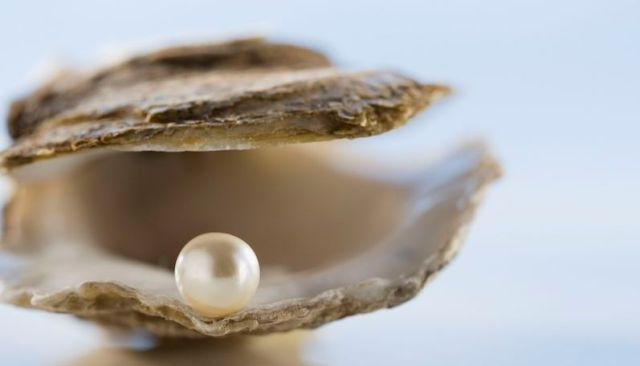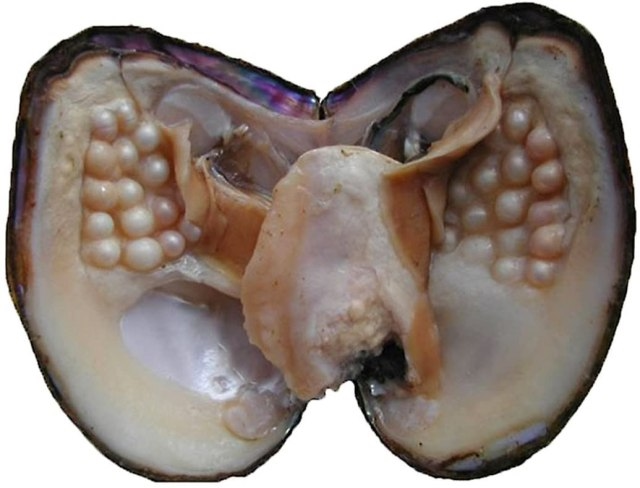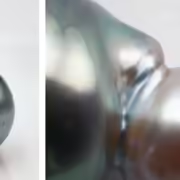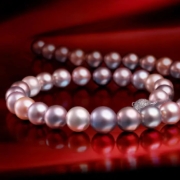Pearl
Pearls, often referred to as “gems of the sea,” are unique and exquisite organic gemstones that have captivated humanity for centuries. Their iridescent luster and timeless elegance have made them a symbol of beauty, wealth, and sophistication across cultures. Formed within the depths of certain mollusks, pearls are a result of nature’s meticulous craftsmanship.


Pearls are spherical or irregularly shaped objects formed within the soft tissue of certain mollusks, primarily oysters and mussels. These gemstones are composed of layers of calcium carbonate crystals known as aragonite, along with a protein called conchiolin. The interaction between these elements, along with environmental factors, contributes to the pearl’s unique visual characteristics.
Brief Overview of Pearl Formation
The fascinating process of pearl formation begins when an irritant, such as a grain of sand or a parasite, enters the soft tissues of a mollusk. In response to this intrusion, the mollusk’s defense mechanism is triggered. It secretes layers of nacre, a combination of aragonite and conchiolin, around the irritant. This process continues over time, with successive layers being deposited, creating a luminous and iridescent pearl.
There are two main types of pearls: natural pearls and cultured pearls. Natural pearls form when the irritant enters the mollusk naturally, without any human intervention. Cultured pearls, on the other hand, are formed through a controlled process initiated by humans. In cultured pearl farming, a nucleus made from mussel shell or a mother-of-pearl bead is introduced into the mollusk’s tissue, kickstarting the nacre deposition process.
The factors influencing a pearl’s quality and value include its size, shape, color, luster (the way it reflects light), and surface quality. Pearls can range in color from creamy white to shades of pink, blue, green, and even black. The overall appeal of a pearl is the result of these unique combinations of characteristics.
Pearls have held a significant place in human culture throughout history, symbolizing purity, wisdom, and luxury. From ancient civilizations to modern fashion runways, pearls continue to evoke a sense of elegance and grace, making them a cherished treasure both in the natural world and in the realm of human adornment.
Contents
- Pearl Formation
- Types of Pearls
- Pearl Jewelry
- Famous Pearls
- Physical Properties
- Occurrence
- Pearl Types and Locations
Pearl Formation

Pearls are formed through a natural biological process within certain species of mollusks, primarily oysters and mussels. The process begins when an irritant, such as a grain of sand or a parasite, enters the soft tissue of the mollusk. In response to this foreign object, the mollusk’s defense mechanism is triggered. The mollusk secretes a substance called nacre, also known as mother-of-pearl, which is composed of alternating layers of aragonite (a crystalline form of calcium carbonate) and conchiolin (an organic protein).
Over time, the mollusk continues to deposit layers of nacre onto the irritant. These layers build up and eventually form a pearl. The lustrous surface of the pearl is created by the way light interacts with the layers of nacre, resulting in the characteristic iridescent sheen that pearls are known for.
Natural vs. Cultured Pearls
- Natural Pearls: Natural pearls are formed entirely by natural processes without any human intervention. They are quite rare and are the result of a chance occurrence of an irritant entering the mollusk. The process of forming a natural pearl can take several years or even decades, and the outcome is often unpredictable in terms of size, shape, and quality.
- Cultured Pearls: Cultured pearls are created through a process that involves human intervention. In pearl farming, a small nucleus, typically a piece of mussel shell or a mother-of-pearl bead, is carefully inserted into the mollusk’s tissue. This irritant serves as a nucleus around which the mollusk deposits layers of nacre, simulating the natural pearl formation process. The controlled environment of pearl farming allows for more predictable results in terms of pearl size, shape, and quality.
Oyster Anatomy and Pearl Formation Process
The anatomy of oysters and other mollusks plays a crucial role in the formation of pearls. Here’s an overview of the process within an oyster:
- Mantle Tissue: The mantle is a specialized tissue within the oyster that plays a key role in pearl formation. It secretes both the nacre and the conchiolin, the two main components of pearls.
- Irritant Intrusion: When an irritant, such as a grain of sand, enters the oyster’s soft tissue, it becomes lodged between the mantle and the shell. In response to this irritant, the mantle begins to secrete layers of nacre to coat and isolate the irritant.
- Nacre Deposition: The oyster continues to deposit layers of nacre onto the irritant over time. This layering process is what creates the pearl’s structure and iridescent appearance.
- Pearl Growth: As more layers of nacre are deposited, the pearl grows in size. The size and shape of the pearl are influenced by factors such as the shape of the irritant and the oyster’s unique biology.
- Harvesting: In pearl farming, cultured pearls are harvested once they have reached the desired size and quality. The oysters are carefully opened, and the pearls are removed. The oysters can be returned to the water to potentially produce more pearls in the future.
Understanding the intricate relationship between mollusks, their anatomy, and the process of nacre secretion provides insight into the captivating journey that results in the creation of these stunning gemstones.
Types of Pearls

There are several types of pearls, each with its own unique characteristics, colors, and origins. Here’s an overview of some of the most well-known types of pearls:
- Freshwater Pearls: These pearls are cultivated in freshwater mussels. They are usually produced in various shapes, including round, oval, and irregular. Freshwater pearls are known for their wide range of colors, from white and pink to lavender and even metallic hues. They are often more affordable compared to other types of pearls.
- Akoya Pearls: Akoya pearls are cultured in saltwater oysters, primarily in Japan and China. They are prized for their classic round shape, high luster, and smooth surface. Akoya pearls are traditionally white or cream-colored, with overtones of pink or silver.
- South Sea Pearls: These pearls are produced by Pinctada maxima, the largest and rarest species of oysters. South Sea pearls are typically larger in size compared to other pearls, and they are known for their satin-like luster. They come in shades of white, silver, and gold.
- Tahitian Pearls: Also known as black pearls, Tahitian pearls are cultured in black-lipped oysters in French Polynesia. Despite their name, they come in a wide range of dark colors, including black, gray, green, and peacock. Their unique colors and overtones make them highly sought after.
- Baroque Pearls: Baroque pearls have irregular, non-symmetrical shapes, which can vary from coin-shaped to elongated or abstract forms. They come in both freshwater and saltwater varieties and are often used in creative and artistic jewelry designs.
- Keshi Pearls: Keshi pearls are non-nucleated pearls, meaning they form without a nucleus in the pearl sac. They can be found in both saltwater and freshwater mollusks. Keshi pearls are typically small and come in various shapes and colors. They are known for their natural and organic appearance.
- Mabe Pearls: Also called blister pearls, mabe pearls are cultivated by attaching a nucleus to the inner shell of an oyster rather than embedding it within the soft tissue. This results in a flat-backed pearl that is often used in earrings, pendants, and rings.
- Biwa Pearls: Historically, Biwa pearls referred to freshwater pearls produced in Lake Biwa in Japan. While the original Biwa pearls are no longer produced due to environmental changes, the term is still used to describe certain high-quality freshwater pearls.
- Fireball Pearls: These pearls, often found in the South Sea and Tahitian varieties, are characterized by their intense and vibrant colors. The term “fireball” refers to their brilliant and fiery appearance.
These are just a few examples of the diverse types of pearls that exist. Each type has its own unique appeal, making pearls a versatile and captivating choice for jewelry and adornment.
Pearl Jewelry

Pearl jewelry has been treasured for its timeless beauty and elegance for centuries. From classic pearl strands to modern and innovative designs, pearls are used in various forms to create stunning jewelry pieces. Here are some popular types of pearl jewelry:
- Pearl Necklaces: Pearl necklaces are perhaps the most iconic and traditional use of pearls in jewelry. They come in different lengths and styles, such as choker, princess, matinee, and opera lengths. A single strand of pearls, often with a simple clasp, is a staple in many jewelry collections.
- Pearl Earrings: Pearl earrings are available in various styles, including studs, dangles, and hoops. They can feature different pearl types, sizes, and colors, allowing for versatility in matching different outfits and occasions.
- Pearl Bracelets: Pearl bracelets add a touch of sophistication to the wrist. They can be made from various pearl types and strung on silk, wire, or elastic cord. Some designs incorporate multiple strands of pearls or combine pearls with other gemstones.
- Pearl Rings: Pearl rings can be both elegant and contemporary. They come in solitaire designs, clusters, and settings that incorporate diamonds or other gemstones. Pearl engagement rings are also becoming a unique choice for those seeking an alternative to traditional diamond rings.
- Pearl Pendants: Pearl pendants feature a single pearl or a cluster of pearls suspended from a chain. They can be simple and minimalist or elaborate and ornate, depending on the design.
- Pearl Brooches: Pearl brooches add a touch of vintage charm and sophistication to clothing. They can feature pearls of various sizes and styles, often combined with other decorative elements.
- Pearl Tiara and Hair Accessories: Pearls are used to create delicate tiaras, hairpins, and combs for special occasions like weddings and formal events. These accessories add a touch of elegance to hairstyles.
- Pearl Statement Pieces: Contemporary jewelry designers often create unique and artistic statement pieces using pearls. These can include asymmetrical designs, mixed-media combinations, and avant-garde concepts that showcase pearls in unconventional ways.
- Pearl Body Jewelry: Pearls can also be incorporated into body jewelry such as belly button rings, anklets, and toe rings, adding a touch of refinement to body adornment.
- Matching Sets: Many jewelry sets include coordinated pieces like necklaces, earrings, and bracelets that feature matching pearls, creating a harmonious look.
Pearls are versatile and can be combined with various metals, gemstones, and materials to create pieces that range from traditional to contemporary. Whether you’re looking for a timeless and elegant piece or a bold and innovative design, pearl jewelry offers a wide range of options to suit different styles and preferences.
Famous Pearls
La Peregrina Pearl
Several famous pearls have gained worldwide recognition due to their size, color, history, and the stories behind them. Here are a few examples of famous pearls:
- La Peregrina Pearl: One of the most famous pearls in history, La Peregrina, was discovered in the 16th century off the coast of Panama. Its name means “The Pilgrim” in Spanish. The pearl’s unique pear shape and size (approximately 50.56 carats) have made it a coveted gem for centuries. It has passed through the hands of various monarchs and celebrities, including Queen Mary I of England and Richard Burton, who famously gifted it to Elizabeth Taylor as a Valentine’s Day present.
- Hope Pearl: The Hope Pearl is a large, natural pearl that measures around 1.7 inches in length. It was once part of the collection of Henry Philip Hope, a gem collector in the early 19th century. The pearl has a remarkable blue-gray color and is often displayed alongside the Hope Diamond in museums due to their similar names and historical connections.
- La Regente Pearl: Also known as the “Regent Pearl,” this perfectly symmetrical, white, and nearly round pearl weighs around 140.5 grains (about 35 carats). It was discovered in the Gulf of Panama in the 16th century. The pearl got its name from the French Regent, Philippe II, Duke of Orleans, who owned it in the 18th century.
- The Queen’s Pearls: Queen Mary II of England possessed an extensive collection of pearls, including a five-strand pearl necklace. The necklace, which has become iconic, was featured in many of her portraits. The Queen’s Pearls have remained a symbol of royal elegance and sophistication.
- Arco Valley Pearl: Discovered in 1982, the Arco Valley Pearl is one of the largest freshwater pearls ever found. It weighs approximately 575 carats and measures over 2 inches in diameter. Its unusual size and shape have contributed to its fame.
- Peregrina Pearl (Revisited): In addition to the historic La Peregrina Pearl, a replica of the original was created in 2011. This replica, known as “La Peregrina II,” was made using a silicone mold of the original pearl. It was commissioned by Elizabeth Taylor’s estate after the original pearl was sold at auction.
- Ducal Pearl Necklace: This necklace, part of the British royal jewelry collection, features a large baroque pearl pendant suspended from a diamond necklace. The pearl is believed to have belonged to Queen Mary I of England and was passed down through generations.
These famous pearls have captured the imagination of people around the world and continue to be admired for their beauty, history, and the stories they tell.
Physical Properties

Pearls are not only prized for their beauty but also for their unique physical properties. Here are some key physical properties of pearls:
- Luster: Luster refers to the way light interacts with the surface of a pearl. Pearls are known for their exquisite luster, which gives them a soft, glowing appearance. The iridescence comes from the overlapping layers of nacre, which refract and reflect light, creating a shimmering effect.
- Color: Pearls come in a wide range of colors, from classic white and cream to shades of pink, lavender, gray, black, and even rare and exotic colors like golden and peacock. The color of a pearl is influenced by the type of mollusk, the water it’s cultivated in, and other environmental factors.
- Size: Pearls can vary greatly in size, from tiny seed pearls to larger pearls that are several centimeters in diameter. The size of a pearl is determined by factors such as the size of the irritant, the mollusk’s biology, and the length of time the pearl is allowed to grow.
- Shape: Pearls come in various shapes, including round, oval, button, drop, baroque (irregular), and circled (with rings around the surface). The round shape is particularly prized and considered the classic pearl shape.
- Surface Quality: The surface of a pearl can have various imperfections, including blemishes, spots, and irregularities. Pearls with smoother surfaces are typically more valuable. However, some types of pearls, such as baroque pearls, embrace their unique surface characteristics.
- Nacre Thickness: The thickness of the nacre layers is a crucial factor in determining the quality and durability of a pearl. Thicker nacre generally leads to stronger pearls with better luster.
- Density and Hardness: Pearls are relatively soft compared to other gemstones, with a hardness of 2.5 to 4.5 on the Mohs scale. This makes them more susceptible to scratches and damage. Their density varies depending on the type of pearl.
- Translucency: High-quality pearls often have a degree of translucency, allowing some light to pass through the layers of nacre. This property contributes to the pearl’s overall radiance.
- Weight: The weight of a pearl is typically measured in carats (the same unit used for diamonds and other gemstones). The weight is influenced by the pearl’s size, density, and type.
- Fluorescence: Some pearls may exhibit fluorescence under certain lighting conditions. This can add a unique dimension to their appearance, especially in pearls with darker colors.
Understanding these physical properties can help both consumers and collectors appreciate the distinctiveness and value of different types of pearls. The interplay of these properties contributes to the allure and charm of pearls as treasured gemstones.
Occurrence

Pearls are formed naturally within certain species of mollusks, including oysters and mussels. The occurrence of pearls involves specific conditions and factors that contribute to their formation. Here’s an overview of how pearls occur:
- Mollusk Habitat: Mollusks that produce pearls inhabit various aquatic environments, including oceans, seas, rivers, and freshwater bodies. Different types of mollusks thrive in different habitats, and the conditions of their environment play a significant role in pearl formation.
- Irritant Intrusion: The pearl formation process begins when an irritant, such as a grain of sand, a parasite, or another foreign object, enters the soft tissue of a mollusk. This irritant becomes lodged within the mantle tissue of the mollusk.
- Nacre Secretion: In response to the irritant, the mollusk’s mantle tissue starts secreting nacre, a combination of aragonite (calcium carbonate) and conchiolin (an organic protein). The nacre is gradually deposited in layers around the irritant. This layering process is what ultimately forms the pearl.
- Layering Over Time: Over time, the mollusk continues to deposit layers of nacre onto the irritant. These layers build up, gradually forming the pearl’s size and shape. The time required for a pearl to form can vary greatly, ranging from several months to several years.
- Natural and Cultured Pearls: Pearls can occur naturally when the irritant enters the mollusk without human intervention. These are referred to as natural pearls and are quite rare. In contrast, cultured pearls are formed through a controlled process initiated by humans. In pearl farming, a nucleus is intentionally introduced into the mollusk’s tissue to stimulate nacre deposition.
- Pearl Types and Locations: Different types of pearls are associated with specific mollusk species and geographic regions. For example, Akoya pearls are primarily cultivated in Japan and China, while South Sea pearls are found in the waters of the South Pacific. Freshwater pearls are cultivated in various freshwater bodies around the world.
- Environmental Factors: The quality and characteristics of pearls are influenced by environmental factors such as water temperature, water quality, and the mollusk’s diet. These factors affect the growth rate, size, color, and luster of the pearls.
- Harvesting: In the case of cultured pearls, once the pearls have reached the desired size and quality, they are harvested by carefully opening the mollusks. The pearls are then removed, and the mollusks can be returned to the water to potentially produce more pearls in the future.
Overall, the occurrence of pearls is a fascinating natural process that involves the intricate interaction between mollusks, their environment, and the specific conditions that lead to the formation of these exquisite gemstones.
Pearl Types and Locations

Pearls come in various types, each associated with specific mollusk species and geographic regions. Different types of pearls are cultivated in various parts of the world, and their unique characteristics make them highly valued in the world of jewelry and adornment. Here’s a breakdown of some pearl types and their locations:
- Akoya Pearls:
- Type: Saltwater pearl
- Location: Primarily cultivated in Japan and China, with Japanese Akoya pearls being particularly renowned. They are also produced in other regions with suitable conditions.
- Characteristics: Known for their classic round shape, high luster, and smooth surface. They are often white or cream-colored, with overtones of pink or silver.
- South Sea Pearls:
- Type: Saltwater pearl
- Location: Cultivated in the warm waters of the South Pacific, including countries like Australia, Indonesia, the Philippines, and Myanmar (Burma).
- Characteristics: Larger in size compared to other pearls, with a satin-like luster. They come in shades of white, silver, and gold.
- Tahitian Pearls:
- Type: Saltwater pearl
- Location: Cultured in black-lipped oysters primarily in French Polynesia, including the islands of Tahiti.
- Characteristics: Known for their unique dark colors, ranging from black and gray to green, peacock, and iridescent overtones.
- Freshwater Pearls:
- Type: Freshwater pearl
- Location: Cultivated in various freshwater bodies, including lakes, rivers, and ponds, around the world. China is a major producer of freshwater pearls.
- Characteristics: Come in various shapes, sizes, and colors, including white, pink, lavender, and metallic hues. Often more affordable than saltwater pearls.
- Biwa Pearls:
- Type: Freshwater pearl
- Location: Originally cultivated in Lake Biwa in Japan. While the original Biwa pearls are no longer produced due to environmental changes, the term is still used to describe certain high-quality freshwater pearls.
- Mabe Pearls:
- Type: Saltwater or freshwater pearl (depending on origin)
- Location: Cultivated in various regions, including Japan, Indonesia, and Australia.
- Characteristics: These pearls are blister pearls, often flat on one side due to their attachment to the shell. They are used in jewelry pieces like earrings and pendants.
- Keshi Pearls:
- Type: Can be either saltwater or freshwater pearls (depending on origin)
- Location: Cultivated in both saltwater and freshwater mollusks.
- Characteristics: Small, irregularly shaped pearls that form without a nucleus. They come in various colors and are often used in artistic and creative jewelry designs.
These are just a few examples of the many pearl types found around the world. Each type has its own distinct characteristics and beauty, making pearls a diverse and captivating choice for jewelry enthusiasts and collectors.




Leave a Reply
Want to join the discussion?Feel free to contribute!